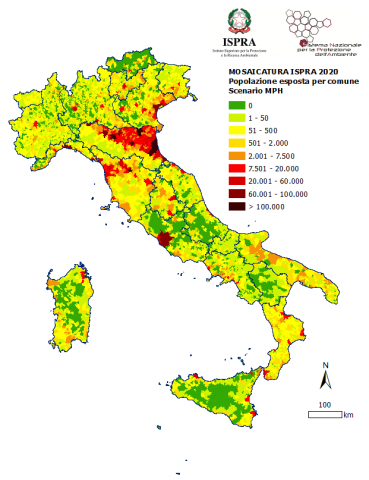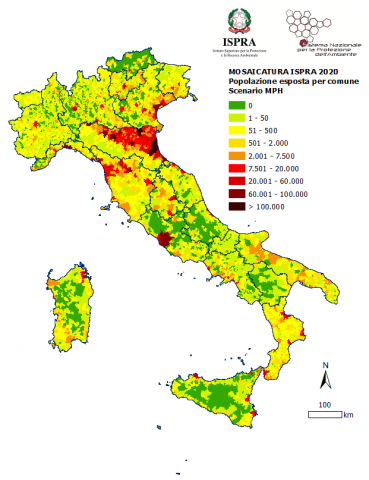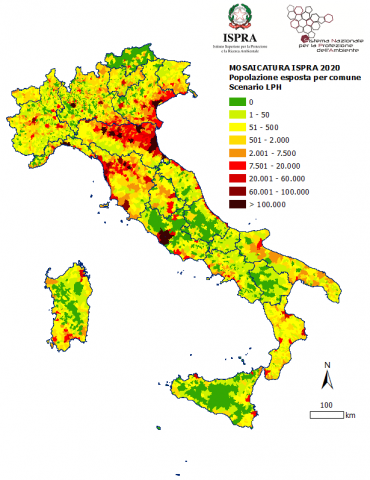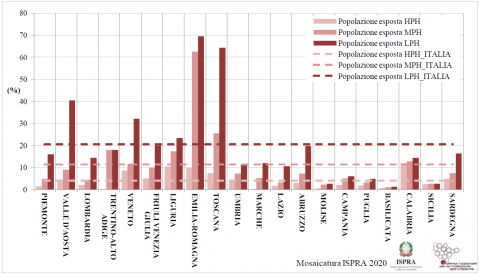Panel 1
Martina Bussettini, Barbara Lastoria
This indicator provides an overview of the population residing in flood-prone areas (population exposed to flood risk) at the national, regional, provincial, and municipal levels. In Italy, the population residing in areas with high hazard/probability is 4.1% of the total national population (2,431,847 people); those exposed to medium hazard/probability are 11.5% (6,818,375 people), while the population in areas with low hazard/probability is 20.6% (12,257,427 people).
The indicator provides information on the population exposed to flood risk in Italy. The estimation was made using the following input data: the ISPRA 2020 National Mosaic (created by ISPRA in 2021), which is based on high hydraulic hazard areas (HPH), medium hydraulic hazard areas (MPH), and low hydraulic hazard areas (LPH), delineated by the Basin Authorities and updated to 2020; population data from the 15th National Census by ISTAT (2011); and ISTAT administrative boundaries (2020). The population exposed to flood risk refers to those living in flood-prone areas who may suffer damages because of flooding (deaths, missing people, injuries, evacuations).
To provide an updated and unified overview of knowledge regarding the population exposed to flood risk at the national, regional, provincial, and municipal levels.
Flood Directive 2007/60/EC
Legislative Decree 49/2010
The aim set by the legislation is to provide an updated overview of flood hazard conditions across the entire national territory.
Panel 2
Lastoria B., Bussettini M., Mariani S., Piva F., Braca G., 2021: Rapporto sulle condizioni di pericolosità da alluvione in Italia e indicatori di rischio associati. Istituto Superiore per la Protezione e la Ricerca Ambientale, Rapporti 353/21, Roma
The indicator provides an overview of the population exposed to flood risk at the national level, detailed down to the municipal scale, based on flood-prone area data updated to 2020 and population data from 2011. It is important to note that flood hazard data are continually updated by the Basin Authorities, and therefore for purposes other than those of this indicator, reference should be made to the information published by these competent authorities.
There is a need to improve the level of spatial coverage of hazard areas especially for high probability scenarios and make better use of information from post-event analyses as part of the Preliminary Risk Assessment.
Data quality assessment
Basin Authority
ISTAT (National Institute of Statistics)
MiTE (Ministry of Ecological Transition).
The 2011 ISTAT Census is available at the link: https://www.istat.it/it/archivio/104317
The mapping of floodable areas is posted on the District Basin Authorities' websites and on the Ministry of Ecological Transition's National Geoportal: http://www.pcn.minambiente.it/mattm/
National, Regional, Provincial, Municipalities
2020
Indicator assessment
To determine the population potentially affected (exposed population) by flood hazard, data from the 15th national population and housing census conducted by ISTAT in 2011 were used, referring to the "Census Sections" territorial base from 2011. The exposed population is the population residing in flood-prone areas, calculated by intersecting in a GIS environment the flood-prone areas layer for each probability scenario with the census section boundaries representing the basic units for the aggregation of ISTAT population data. The population of each section within the flood-prone area is weighted according to the percentage of the section covered by the floodable area. Essentially, assuming no exact population location within the sections, a uniform distribution within each census section is adopted.
A significant increase in the population was observed due to the expansion of flood-prone areas. This increase is attributed to new studies, modeling, the use of data from past flood events, and future scenarios that account for the effects of climate change.
Based on the analysis of the population residing in potentially flood-prone areas, the following results were found:
- The population residing in areas with high hazard/probability (Figure 1) is 4.1% of the total national population (2,431,847 people).
- The population exposed to medium hazard/probability (Figure 2) is 11.5% (6,818,375 people).
- The population residing in areas with low hazard/probability (Figure 3) is 20.6% (12,257,427 people).
Compared to the ISPRA 2017 mosaic, the population residing in areas with high hazard/probability (HPH) from the ISPRA 2020 mosaic increased by 0.6 percentage points. Those exposed to medium hazard/probability (MPH) increased by 1.1 percentage points, while the population in areas with low hazard/probability (LPH) increased by 4.9 percentage points.
Data
Table 1: Values of population residing in flood-prone areas in Italian provinces for different flood probability scenarios expressed in absolute terms (no. inhabitants) and percentages (%) of the total population of each province (Prov. Population)
ISPRA processing of District Basin Authority and Istat data
ID = Istat code of the province





The ISPRA 2020 mosaic, created in 2021 based on data updated to 2020, provides the extent of potentially flood-prone areas for flood probability scenarios defined by Legislative Decree 49/2010. This is based on the delineations produced by the Basin Authorities during the update of flood hazard and risk maps for the second management cycle of the European Directive 2007/60/EC.
The regions of Veneto, Liguria, Emilia-Romagna, and Tuscany have higher percentages of population exposed to flood risk compared to the national values for all hazard scenarios (Figure 4). The highest percentages of population exposed to flood risk are observed in:
The province of Ferrara in Emilia-Romagna has a population exposed to flood risk that, in the case of medium (MPH) and low (LPH) hazard scenarios, represents 100% of the resident population. Similar percentages are observed in Veneto, in the province of Rovigo, with regard to the low flood probability (LPH) scenario.
In Lombardy, the province with the highest percentage of flood-prone area (Mantova) is also the one with the highest percentage of population exposed, but only for the high hazard (HPH) scenario. Meanwhile, Cremona and Sondrio are Lombardy provinces with the highest percentages of population exposed, respectively, for the medium (MPH) and low (LPH) hazard scenarios. In Friuli-Venezia Giulia, the provinces with the highest percentage of population exposed are Gorizia (HPH) and Udine (MPH and LPH). In Tuscany, the provinces with the highest percentages of population exposed are Pistoia (HPH), Pisa (MPH), and Prato (LPH). In Calabria, Crotone not only has the highest percentage of flood-prone areas but also the highest percentage of exposed population (Table 1).